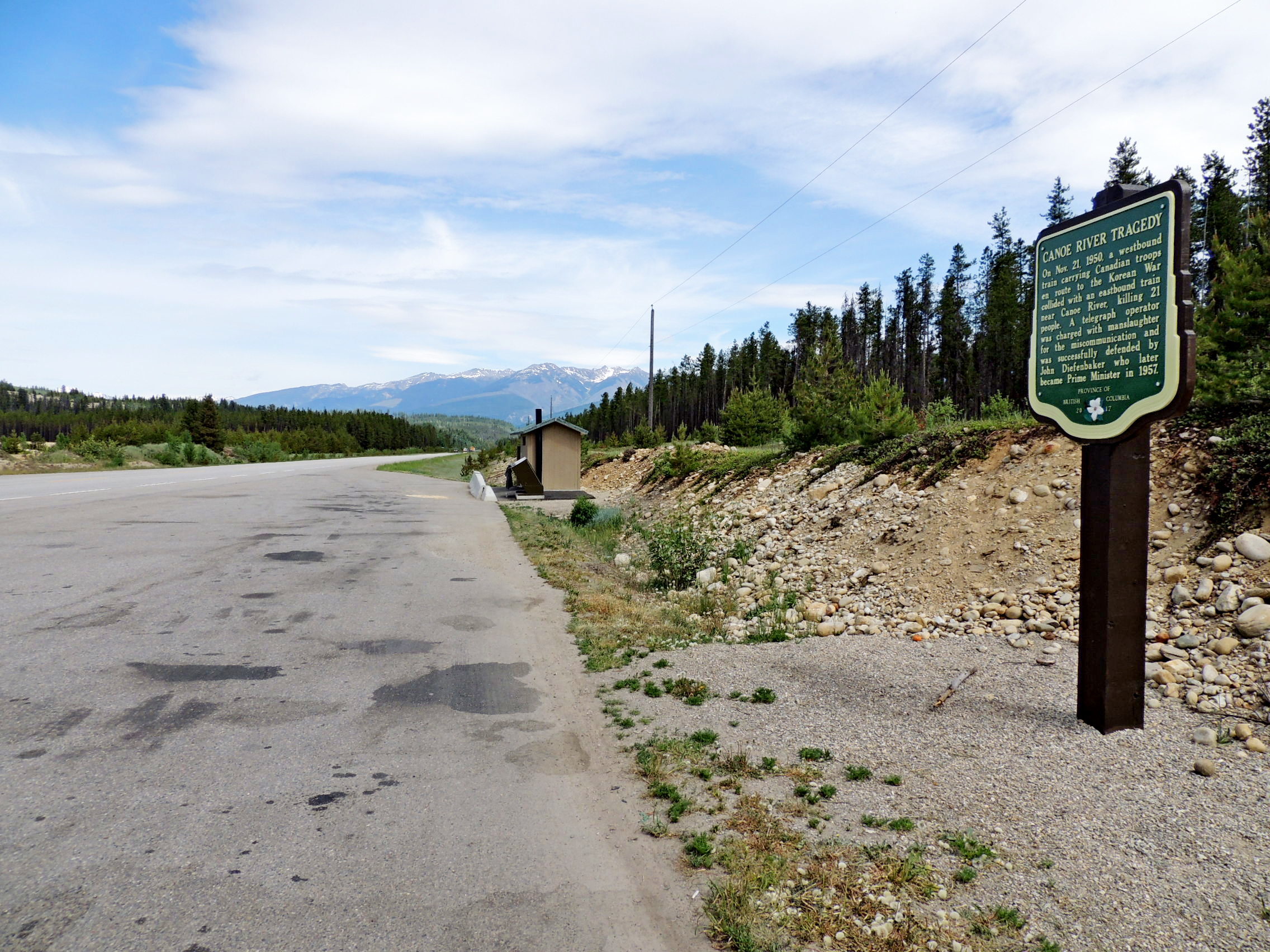The marker relates the story of what came to be known as the
Canoe River Tragedy, a railroad accident in which 21 persons, 17 Canadian soldiers on their way to fight in the Korean War, and 4 train engineers, were killed. The tragedy occurred very near this marker, the Canadian National tracks where the crash happened being just west of the highway.
The 17 soldiers who died in the wreck had come from across Canada:
Arden Atchison (Loon Lake, Sask.), Weldon Barkhouse (Wolfville, N. S.), Norman Carroll (Pennant, Sask.), Frederick Conway (Grand Falls, Nfld.), Robert Craig (Foam Lake, Sask.), Austin George (Eight Island Lake, Nfld.), Urbain Levesque (Ottawa, Ont.), Robert Manley (Niagara Falls, Ont.), Basil McKeown (Moscow, Ont.), Albert Orr (Calgary, Alberta), David Owens (Granby, Quebec), Leslie Snow (St. Johns, Nfld.), Albert Stroud (Howley, Nfld.), Joseph Thistle (Conception Bay, Nfld.), James Wenkert (Cowansville, Quebec), James White (Placentia Bay, Nfld.) and William Wright (Neepawa, Man.).
Harvey Church was the engineer on the troop train; he was 49. The fireman, Henry Prosinuk, had just transferred to Jasper from Edmonton a week earlier. Jack Stinson was driving the transcontinental train, accompanied by fireman Adam Oleschuk.
A cairn with a plaque containing the simple words
21.11.50 - 2nd Field Regiment - RCHA
was erected at the site in 1987 by the Royal Canadian Horse Artillery. In the nearby town of Valemount a Howitzer and a granite cairn out front of the Legion on Main Street are also memorials which remember the tragedy.
CANOE RIVER TRAGEDY
On Nov. 21, 1950, a westbound train carrying Canadian troops en route to the Korean War collided with an eastbound train near Canoe River, killing 21 people. A telegraph operator was charged with manslaughter for the miscommunication and was successfully defended by John Diefenbaker who later became Prime Minister in 1957.
PROVINCE OF
BRITISH COLUMBIA
2017
TRAGEDY AT CANOE RIVER
by Shirley Kolanchey
On June 24, 1995 members of Edmonton's KVA Unit 21 and others gathered to remember 17 members of the 2nd Regiment Royal Canadian Horse Artillery headed for the Korean War but who never reached their goal. Their special troop train collided with the Eastbound Continental CN No. 2 passenger train near Canoe River, B.C. on November 21, 1950.
"At Cedarside" had been omitted from a telegraph message delivered to the troop train at Red Pass Junction. Instead of the train going to a siding at Cedarside, between Valemount and Canoe River, it continued another eight km. to Canoe River and met the No. 2 train when it came around a mountain curve at full speed.
In the quiet setting, surrounded by tall trees, snow-capped Rocky Mountains and an overcast sky, 125 people—Korean War veterans and their families, friends, relatives of the deceased, military personnel, Legion members and CN employees—came from the three Western provinces to honor the soldiers and also the train crews who were killed.
"It revived more painful memories than I expected," says John Stables of Edmonton, who first returned to the site at the time of the memorial service. He was one of the soldiers who had boarded the train at Shilo, Manitoba, bound for Fort Lewis, Wash., where they were scheduled to sail for Korea.
He remembers some details of the crash very clearly. He was playing cribbage with three comrades when all of a sudden they were thrown forward, breaking the table. They thought the train may have run into a land slide or pile of rocks on the rail bed.
"I opened the coach door on the down-side and on looking towards the front of the train, saw all of the coaches in front of us were off the track. The engines, baggage cars and some of the coaches were down the hill piled on top of one another."
He jumped out and ran toward the coaches, then started pulling at splintered wood and other debris to help the injured get out. "I was using a rifle as a pry bar when a young officer said, 'Don't you know you are damaging military equipment using a rifle as a pry bar.' The officer must have been in shock."
He spent quite a bit of time on top of the wreck helping to remove the injured and dead; some were personal friends. "Probably because I had been subjected to scenes of injury and death during the 2nd World War helped me somewhat to deal with the situation," he feels even now. Many of the younger soldiers had been in uniform only a few weeks.
Stables also recalls seeing a railroad watch on one of the train crew who was killed. His crushed watch had stopped at the time of the wreck—10:35.
From KVA Canada

